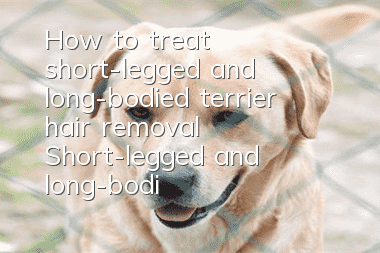How to treat short-legged and long-bodied terrier hair removal? Short-legged and long-bodied terrier hair removal treatment method

What should I do if my short-legged and long-bodied terrier loses its hair? Canine alopecia, also known as alopecia, alopecia or hypotrichosis, is a general term for partial or systemic hair loss. Some pet parents are very worried about the phenomenon of hair loss in dogs. Most of them think that there is something causing the dog to shed a lot of hair.
Regarding this situation, everyone must stay calm, find out the cause and what factors caused it, and then take further action. This kind of alopecia can occur in various dogs. Its early changes include pigmentation, dandruff, and sparse coat. Later, alopecia appears, which is symmetrically distributed on the abdominal ribs, chest and femoral areas of the dog's body.
1. Causes of hair loss in dogs:
Alopecia is divided into two types: congenital and acquired:
1. Congenital nature is seen in heredity;
2. Acquired alopecia is often secondary to systemic diseases such as neurological diseases, endocrine diseases (thyroid and pituitary disorders, testicular and ovarian dysfunction), febrile diseases (pneumonia or infectious diseases, etc.), nutritional disorders, Toxic diseases and certain cachexia, etc.;
3. External stimulation can also cause alopecia;
2. Key points for diagnosis of hair loss in dogs:
1. Congenital alopecia: When a dog is born, it is occasionally seen that there is no hair on the forehead, top of the head, lower abdomen, thighs, etc. This phenomenon is more common in poodles. Black and white mixed dogs gradually lose hair on their black hair at 4 weeks of age. These are all hereditary hair loss. The genetic mutation occurs in blue or red Dobermans, blue dachshunds, and Wilbur setters, which are born with normal coats but soon begin to lose their hair.
2. Acquired hair loss: Hair loss often starts locally, and then merges with lesions in adjacent areas. The bald area gradually expands, accompanied by flakes. Neurogenic and endocrine alopecia: skin lesions occur symmetrically. Hair loss occurs first on the medial thighs, neck friction and other parts of the body. By about 1 year old, hair loss occurs to varying degrees in all parts of the body except the head and limbs, with pigmentation and A lot of scales, sometimes looking like red pimples
3. Pituitary hormone disorder, leading to hypogonadism. This disease is more common in shepherd dogs.
4. Ovarian insufficiency can easily lead to obvious pigmentation and thickening of the skin around the pubic area, groin, and chest, which can easily induce seborrheic dermatitis, leading to hair loss in dogs
5. Hair loss caused by other reasons: Toxic alopecia is mainly caused by mercury, thallium and other poisonings. When the central nervous system is poisoned, erythematous dermatitis occurs in many parts of the skin, causing hair loss, scabs, and ulcers. Symptoms of digestive tract and kidney poisoning also occur. Dystrophic hair loss: body weight loss, dull coat, and skin loss of elasticity.
3. Prevention and treatment measures for dog hair loss:
1. Correctly identify the cause of the disease, treat the primary disease, and treat the symptoms at the same time. Remove scales from the hair removal area and stimulate the hair roots andThe principle is to expand skin capillaries to provide sufficient nutrition to hair follicles and promote hair regeneration.
2. You can use 1% pilocarpine ointment, 40% lecithin ointment, and 1% acetylcholine chloride ointment. Apply it every day and massage gently. You can also mix 18g of salicylic acid, 18g of tannic acid and 600ml of ethanol and apply it to the affected area.
3. For endocrine alopecia, use hormonal therapy, prednisone 2 mg/kg body weight subcutaneous injection, administration of male hormones or sterilization surgery. For those with ovarian insufficiency, the ovaries and uterus can be removed.
4. In addition to targeted treatment for toxic hair removal, cystine and methionine can be administered. For hair loss caused by hypothyroidism, thyroid preparations can be taken orally, 2 tablets a day, gradually increasing to 6-10 tablets.
5. For other dogs with unexplained hair loss, apply a hair regeneration stimulator locally.
6. The living environment of pet dogs should be kept dry, disinfected regularly, and pathogenic microorganisms should be killed. If necessary, pet dogs should be equipped with insect-proof collars.
7. Comprehensively strengthen the dog’s nutrition and provide sufficient protein, vitamins and trace elements to improve the dog’s resistance. If hair loss is discovered, timely diagnosis and treatment is required.
- What to do if a Border Terrier has a fever? What to do if a Border Terrier has a fever?
- What to do if Border Terrier has mites? What to do if Border Terrier has mites?
- How to test puppy personality How to test puppy personality
- How to treat burns on short-legged and long-bodied dogs. How to treat burns or burns.
- What are the personality traits of dogs? An introduction to the personality traits of dogs
- How to feed Border Terrier? Key points for feeding Border Terrier
- How to clean Basenji dog ears How to clean Basenji dog ears
- How to train a Border Terrier not to bark? How to train a Border Terrier not to bark?
- How to train a Basenji dog to cross obstacles. Tips for training a Basenji dog to cross obstacles.
- How to remove dog lice from Border Terrier How to remove dog lice from Border Terrier



